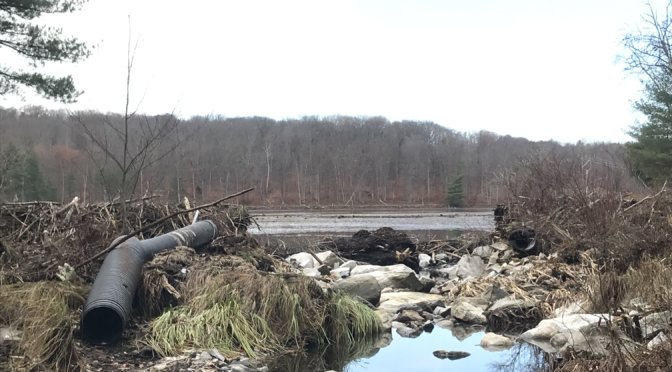By Tom Estill
During the first week of fall, you could find trees turning their beautiful fall foliage colors and many birds, including robins, red-eyed vireos, yellow-bellied sapsuckers, Eastern towhee, yellow-throated vireo, white-throated sparrow, wood ducks, Canada geese, great blue heron and myrtle warbler migrating south through the forest. On Sept. 25th, these migrating birds, along with year round residents such as tufted titmouse, white-breasted nuthatch, black-capped chickadees, blue jay, hairy woodpecker, red-bellied woodpecker, pileated woodpecker, and Cooper’s hawk were all seen on that same day. Asters were still flowering and American chestnut burs, from the lone known wild American chestnut known in the park, and acorns were falling onto the forest floor. Because American chestnut trees need two different trees to
produce viable seeds, those seeds found in the burs were small infertile seeds. Chipmunks and gray squirrels were scurrying about. While walking along middle Giorgetti trail, I heard a massive pine tree crash to the ground on lower Giorgetti trail, shaking the ground beneath my feet. On closer inspection, I could see the core of the tree was rotten. This late into Sept. you could still see a common sulfur butterfly flying about.
By the second week of October, fallen leaves were covering most of the trails of the park, and acorns covered the ground in huge numbers. It was going to be a good MAST year indeed. In my opinion, shared by many, fall foliage season was a bust this year. Colors just were not as colorful and vibrant as years past. Squirrels and gray squirrels were busy collecting the fallen acorns.
During a walk on Oct. 9th, crows were seen in large numbers, as is common this time of year, but the only other place I saw birds was around Muddy Pond.The birds I saw there were Canada geese, wood ducks, hairy and pileated woodpecker, blue jay, white-breasted nuthatch and golden-crowned kinglet.
During a walk on Oct. 19th, I noticed the forest floor covered with a thick layer of leaves, and just a very few acorns still falling. I did not hear or see a single bird, which is a rarity for me. That disappointment was offset by having a magnificent doe slowly walk across the Carriage Trail right in front of me. I was sitting on a log tying my boots at the time and it just didn’t see me. Gray squirrels and chipmunks still gathering acorns.
On Oct. 23rd, I went on an early morning birdwalk and once again saw not a single bird, except crows flying overhead. Leaves were still falling with many trees still having lots of attached leaves. Through my binoculars I could see that the oak trees were pretty much finished dropping their acorns. Still no good, hard frost in the area.
On the first day of Nov. on an evening walk, once again the only birds seen were crows flying overhead and a few hundred geese resting at Muddy Pond. Most of the leaves were gone from the tops of most trees with the exception of oak and beech trees. Chipmunks and gray squirrels
still out collecting acorns. And at the end of my walk, as I’m checking myself for ticks, sure enough, there’s two ticks crawling on my pant legs. Temps. were forecast to be in the 20s later in the week, bringing an end to the ticks until next spring.
A few days later I’m out on an early evening walk and saw white-breasted nuthatches,
black-capped chickadees, northern flicker, a large flock of robins migrating through the forest, crows, downy woodpecker, tufted titmouse, red-bellied woodpecker, Canada geese at Muddy Pond, and many chipmunks and gray squirrels.
On Nov. 7th, I was lucky enough to see bluebirds near the trailhead, along with blue jays, black-capped chickadees, tufted titmouse, and white-breasted nuthatches.
On Nov. 11th, I noticed something I had never seen before at Rocky Pond. The water was
tinted green with algae. Even in the middle of summer, when pond temperatures are high, I had never seen the ponds turn as green in color as I saw on this day. But the big news I received on this day from Shelley Lutz was that the beaver dam on Muddy Pond had collapsed the day before! As I’m headed towards the dam on the Carriage Trail, I could hear the roar of water
from a couple hundred yards away. Sure enough, about 15 ft. of the dam center had collapsed. Water in the pond was already very low. It looked like it had drained about 5 ft. There were a few deep spots on the pond still covered with water being used as a resting place for a few hundred migrating Canadian geese.
On a late afternoon hike on Nov. 22nd, the only bird I saw was a white-breasted nuthatch. No chipmunks were seen, but a few gray squirrels were busy collecting acorns. Rocky pond still had a green tint to it. No migrating birds were seen at either pond.
During the first week of December, both ponds had finally frozen over with the exception of a few areas on the perimeters, only a few gray squirrels were seen, and though temperatures were cold, there was little snow and ice on the forest floor.
On a mid-Dec. day, during a late afternoon walk, no birds or mammals were seen, recent rains and warming had melted all recent snow and ice on the forest floor, a few areas of open water could be seen at both ponds, and the peripheral ice at Rocky Pond was thin, breaking very easily.
That’s it for this issue. Please stay on the trails and enjoy your time at the park.

